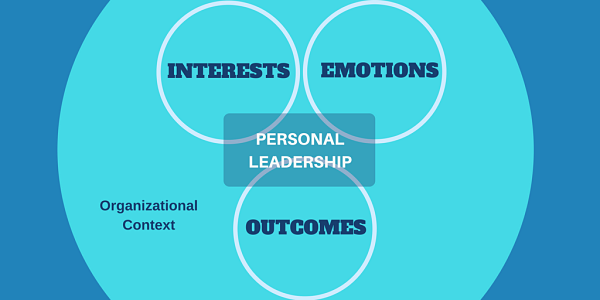Why are we talking about multiple leadership dimensions instead of trying to reduce complexity? Focus on one thing and do it right.
What could be then the one thing a leader should focus on to ensure that the change process is successful?
What if this is the wrong question? What if, in order to be successful, a leader’s focus should be multi-dimensional?
A change leader’s activity takes place in a complex environment with multiple forces at play. Change leaders are, at the same time, part of this complex system, and influencers of the system.
Everything should be made as simple as possible, but not simpler.
A. Einstein
How much are we allowed to simplify the complexity of a business system undergoing change, without making it “simpler”?
According to the model developed by Mike Green, Andy Holder, and Mhairi Cameron, the 3 main leadership dimensions for a successful change leader are:
– Outcomes: deliver results
– Interests: mobilize influence, authority, and power
– Emotions: help people to adapt and create cultures that enable change
Change Leaders Develop These 3 Leadership Dimensions
Outcomes
This dimension is related to delivering results (financial results, successful projects, and successful organizations).
For some, outcomes are the fundamental dimension of leadership. The only one even.
You’re right. No business can function without generating revenue, but it will be rather sad if the role of a business was reduced to only generating revenue.
Managers will learn early on in their careers that results (outcomes) matter. However, a leader will understand that, even outcomes are a key element of leadership, there is something more to the equation. And they will have to focus their attention on all these additional elements.
Interests
This dimension is focused on creating a network of influence and building authority.
For the leader who wants to act as a change agent, mobilizing influence, authority, and power is an important element. It contributes to the outcome of every change process, be it a smaller change or a large business transformation endeavour.
Long term objectives are also dependent on how well we, as change agents, focus on this element.
The success of a change process depends on how well we balance strategy and tactics, how well we can focus on both short-term and long-term objectives. And, also, how well we understand that short-term and long-term influence each other.
Emotions
In a pragmatic world, where results are the defining measure of success, it’s important for leaders to understand emotions: theirs and others.
It’s pretty difficult to talk about emotions as a dimension of leadership.
To clear any possible confusion: “Emotions” in this context go beyond self-awareness. Being aware of their own emotions is important for leaders and it becomes even more important during times of change when stress and pressure are higher than usual.
But self-awareness is only one aspect of this leadership dimension. In addition to being aware of his own emotions, a good leaders has to be capable of understanding the emotions at play in the surrounding environment. This capacity will help uncover tensed situations and potential conflicts. It will also help foster the kind of culture that will enable change, instead of hindering it.
Your chances of success as a leader of change depend on your capacity to keep your eyes on all these three balls (leadership dimensions) at the same time.
Change starts with the individual, is enabled by the team, and it’s successful (or not) at the organization level. But change happens differently at each one of these levels. The role of the change leader is to understand the subtleties.
As a change agent, you will need to be constantly aware of what happens at the organizational, team, and individual level. And, not only be aware, but also understand how you can better react.
And, to add even more to the complexity, you’ll have to gain the capacity to balance speed of reaction with reflection.
In complex environments, and under pressure, it’s easy to react based on intuition. However, having a deeper understanding of the theories developed around how individuals go through change, the dynamics of team development, and the theories related to organizational change will help you better understand what is going on, what you should do about it, and how you can enrol others to help you.
Resources:
Mike Green, Esther Cameron – Making Sense of Change Management: A Complete Guide to the Models, Tools and Techniques of Organizational Change






